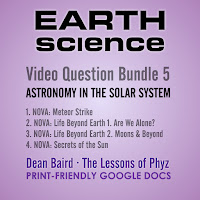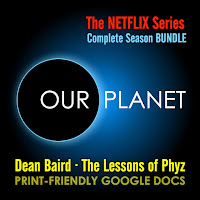My high school physics and science curriculum at TPT, Pearson Education, Arbor Scientific, and PhET
Thursday, November 5, 2020
Earth Science 6: Astronomy Beyond the Solar System
Thursday, October 29, 2020
Earth Science 5: Astronomy in the Solar System
Thursday, October 22, 2020
Earth Science 4: Tectonics, Volcanoes, and Earthquakes
Thursday, October 15, 2020
Earth Science 3: Climate Change and Human Impact
Thursday, October 8, 2020
Earth Science 2: Atmosphere and Weather
Thursday, October 1, 2020
Earth Science 1: Science, Mapping, and Water
Sunday, August 16, 2020
How Earth Made Us | How the Earth Changed History
BBC · 2010 · Presenter: Iain Stewart
Professor Iain Stewart examines the role of geology in the history of mankind in this documentary program. Each of the classical elements plays a role - for instance, he points out that mankind has been drawn to fault lines for centuries, since this is the best place to find minerals, oil, soil suitable for farming, etc. But with these riches comes great danger, of course, since locating communities on the fault lines makes them vulnerable to earthquakes. Subsequent episodes review the cycle of freshwater, the force of the wind, and fire both as a source of energy and a terrifying force of nature. From crystal caves in Mexico to holes in the Iranian desert and a mysterious lake in Oregon, Stewart travels the globe to hammer his point home.
How Earth Made Us | How the Earth Changed History on Teachers Pay Teachers
E P I S O D E SIn this first episode, Iain explores the relationship between the deep Earth and the development of human civilisation. He visits an extraordinary crystal cave in Mexico, drops down a hole in the Iranian desert and crawls through 7,000-year-old tunnels in Israel.
His exploration reveals that throughout history, our ancestors were strangely drawn to fault lines, areas which connect the surface with the deep interior of the planet. These fault lines gave access to important resources, but also brought with them great danger.
Sunday, August 2, 2020
Our Planet
Netflix · 2019 · Narrator: David Attenborough
Share the wonder of the extraordinary place we call home. Utilizing the latest technology Our Planet was filmed entirely in Ultra High Definition in over 50 countries. From exotic jungles to the deepest seas, open your eyes to the connections we all share.
Just some of the buzz for Our Planet:
'Our Planet' Is A Remorseful Call To Arms [NPR's Fresh Air - 26 April 2019]
Staggering, Marvelous Our Planet Is the Nature Show We’ve Been Waiting For [Variety - 9 April 2019]
Our Planet on Teachers Pay Teachers
E P I S O D E SThe habitats that make up our planet are connected and reliant upon each other. The astonishing diversity of life on earth depends on these global connections. Witness the planet's breathtaking diversity—from seabirds carpet-bombing the ocean to wildebeests eluding the wild dogs of the Serengeti.
2. FROZEN WORLDS
Our poles are some of the earth's last remaining wildernesses. And yet just as we are beginning to understand these extraordinary places, they are changing fast. On the unforgiving frontier of global warming, polar bears, walruses, seals and penguins find their icy Edens in peril.
Sunday, July 26, 2020
Conceptual Physics Alive!
1. INTRODUCTION
Author Paul Hewitt describes the perspective taken in the Conceptual Physics program and offers a preview of things to come. The program begins with a description of how the video series came to be. Enjoy the clips from the “old days” going all the way back to 1974!
Sunday, July 19, 2020
Breakthrough: The Ideas That Changed the World
PBS BBC · 2018 · Narrator: Patrick Stewart
Take a mind-blowing journey through human history, told through six iconic inventions that modern people take for granted, and see how science, invention, and technology built on one another to change everything.
This series spotlights the history of engineering, which aligns nicely with the NGSS emphasis on engineering. While Patrick Stewart narrates, there is refreshing representation among the various presenters who appear throughout the series.
Breakthrough: The Ideas That Changed the Word on Teachers Pay Teachers
E P I S O D E SEpisode 1 tells the story of the development of the telescope, from a stone-age observatory to the space-based telescopes of the future.
Scholars Derrick Pitts (The Franklin Institute), Brett Salmon & Dan Coe (Space Telescope Science Institute), Fabio Silva (Bournemouth University), Shelley James (Glass Artist), Jim Al-Khalili (University of Surrey), Binh Danh (San Jose State University), and Lindsay Smith Zrull (Harvard Observatory) tell us the story of the telescope.
It entails long-abandoned Stone Age dolmens once used as celestial calendars, how Venetians made glass transparent, the optics of a medieval Persian camera obscura, a Dutch lens maker’s wartime breakthrough and a Venetian math teacher’s advancement of it, a Parisian invention improved by a spilled bottle of mercury, a team of women known as human computers who were armed with fly spankers, an athlete-turned-astronomer working high above Los Angeles, and telescope in space that will allow us to see as far as physics will allow.
Episode 1 "breakthrough celebrities" include Galileo Galilei, Edwin Hubble, Henrietta Swan Leavitt, Louis Daguerre, Hans Lippershey, and Ibn al-Haytham.
Sunday, July 12, 2020
The Mechanical Universe: College
The Mechanical Universe...and Beyond is a critically-acclaimed series of 52 thirty-minute videotape programs covering the basic topics of an introductory university physics course. The series was originally produced as a broadcast telecourse by the California Institute of Technology and Intelecom, Inc. with program funding from the Annenberg/CPB Project.
Each program in the series opens and closes with Caltech Professor David Goodstein providing philosophical, historical and often humorous insight into the subject at hand while lecturing to his freshman physics class. The Mechanical Universe contains hundreds of computer animation segments, created by Dr. James F. Blinn, as the primary tool of instruction. Dynamic location footage and historical re-creations are also used to stress the fact that science is a human endeavor.
The series has been broadcast as a telecourse over the PBS television network and can still be seen on many PBS stations. The Mechanical Universe is arguably the most successful attempt to date to use video technology in the presentation of rigorous physics instruction.
Sunday, June 14, 2020
One Strange Rock
Monday, April 13, 2020
Cosmos: A Spacetime Odyssey
National Geographic · 2014 · Presenter: Neil deGrasse Tyson
Cosmos: A Spacetime Odyssey, is a thirteen-part American science documentary television series released in 2014. The show is a follow-up to the 1980 television series Cosmos: A Personal Voyage, which was presented by Carl Sagan is considered a milestone for scientific documentaries. This series was developed to bring back the foundation of science to network television at the height of other scientific-based television series and films. The show is presented by astrophysicist Neil deGrasse Tyson, who, as a young high school student, was inspired by Sagan.
Cosmos: A Spacetime Odyssey on Teachers Pay Teachers
E P I S O D E STyson opens the episode to reflect on the importance of Sagan's original Cosmos, and the goals of this series. He introduces the viewer to the "Ship of the Imagination", the show's narrative device to explore the universe's past, present, and future. Tyson takes the viewer to show where Earth sits in the scope of the known universe, defining the Earth's "address" within the Virgo Supercluster. Tyson explains how humanity has not always seen the universe in this manner, and describes the hardships and persecution of Renaissance Italian Giordano Bruno in challenging the prevailing geocentric model held by the Catholic Church. To show Bruno's vision of the cosmic order he uses an animated adaptation of the Flammarion engraving, a 19th century illustration that has now become a common meme for the revealing of the mysteries of the Universe.
The episode continues onto the scope of time, using the concept of the Cosmic Calendar as used in the original series to provide a metaphor for this scale. The narration describes how if the Big Bang occurred on January 1, all of humankind's recorded history would be compressed into the last few seconds of the last minute on December 31. Tyson concludes the episode by recounting how Sagan inspired him as a student as well as his other contributions to the scientific community.
Sunday, February 23, 2020
Pandemic: How to Prevent an Outbreak
Netflix · 2020
In Pandemic: How to Prevent an Outbreak, we meet the heroes on the front lines of the battle against influenza and learn about their efforts to stop the next global outbreak.
Pandemic: How to Prevent an Outbreak on Teachers Pay Teachers
E P I S O D E SIn this introduction to life on the front lines, doctors in the U.S. and Asia battle the flu, and researchers race to develop a universal vaccine.
Vaccine debates rage while health-care workers inoculate against the Ebola virus in Congo and influenza in detainee camps at the U.S.—Mexico border.
Worldwide, scientists test animals and their handlers for emerging viruses. In the U.S. and India, doctors work long hours caring for flu patients.













